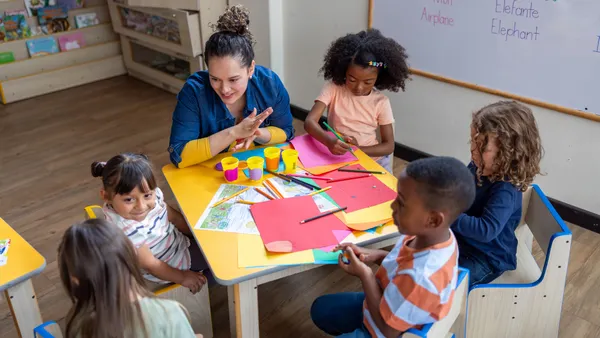To Carolyn Sykora, educators who want to bring computational thinking into the classroom should first see themselves as students, too. The senior director of the ISTE Standards programs doesn’t believe educators need to have a degree, nor any expertise, in the field to get started.
Instead, just leaping in can be beneficial — and also empower their own students to try.
“That approach allows you to learn with students, and allows students to see you as an adult learning, as well,” Sykora told Education Dive.
Computational thinking, which ISTE calls a “problem-solving process," is an approach that breaks challenges into manageable steps to come up with a solution that can ideally be used again, overlaid across future objectives. Educators can think of the approach as the way a computer would solve a problem, taking one simple action and then another.
How or where to get started teaching children about the use of computational thinking, however, can often stymie educators. But Sykora believes classes in many subject areas — even a dance class — can make good use of these tools, where children as young as elementary students can benefit from being taught the basics of this approach.
Dance moves
One reason ISTE’s Sykora recommends bringing computational thinking into younger grades is how, as a problem-solving skill, the tool offers “another set of lenses that students can wear,” she said.
While very young children may not fully understand the concept of computational thinking at the start, laying the building blocks in these early grades can help them develop these skills as they continue with their education, whether that’s as future mathematicians or artists.
She’s seen students use the approach in design classes, breaking down how much clay they will need to build a three-dimensional sculpture. An elementary school group also adopted the approach while learning the choreography for a dance performance for parents. The teacher added computational thinking skills by assigning students to teach their dance moves to classroom robots.
The dance lessons were themselves a kinesthetic, active learning experience — ideal for younger children. The second layer, having to break down what they learned into a sequence of steps, added the computational learning element so students could learn to problem-solve and to code the robots.
“Computational thinking lends itself nicely to design and creative thinking,” she said.
Rubber band models
Kevin Waterman, a project director with the nonprofit Education Development Center (EDC), develops science curriculum for schools, helping teachers pilot materials with a particular focus on computational thinking. He believes real-world and hands-on learning are optimum ways to bring this approach into classrooms, particularly with elementary and middle school students.
For the EDC’s WeatherX project, for example, he helped build computational thinking skills into extreme weather lessons for 8th graders in New Hampshire and Massachusetts. The students are “looking at factors that went into a particularly bad storm,” he told Education Dive, and then use that information to build data models.
Another EDC project Waterman is shepherding integrates science and computational thinking models into lessons for elementary school students. With elementary schools, where a wide range of technology tools aren’t always available, hands-on learning is crucial.
One lesson, for example, helps children look at the relationship between sound and vibration using simple rubber bands. Children are shown a model on a single computer screen and then given rubber bands to stretch as they learn about tension.
“I go back to the Common Core for math that says to use tools appropriately,” Waterman said. “It’s important to know when to pull a calculator out and when to go slowly and deliberately so you don’t miss something.”
Mike Nesterak, senior director of the NWEA's Product Innovation Center, agrees helping students understand why they need a tool — or don’t — is important, and computational thinking can help children learn how to approach and consider problem-solving options.
At NWEA, Nesterak focuses on equity in assessment building and how computational thinking can be integrated into testing so students are assessed less on their mastery of a specific skill, but more on the way they think, and their ability to problem-solve.
“It’s really not just okay that they memorized their multiplication tables and then move on to the next,” he said. “We want to get away from rote recall of information and think about how they think, and that’s one of the underlying aspects of computational thinking.”
Everyday tasks
At the Los Angeles Unified School District, computational thinking is woven into all lessons, not just those involving science and technology — and also into instruction around basic routines, as well. Teachers are shown how to make these connections across all areas of the curriculum in the nation’s second-largest school district, said Sophia Mendoza, director of the Instructional Technology Initiative for LAUSD’s Division of Instruction.
“Computational thinking is not just about programming or coding,” she said. “The four computational thinking elements of decomposition, abstraction, pattern recognition and algorithm designs are connected to content area lessons.”
That can mean, Mendoza said, using these skills with students as they break down and reduce fractions in a math class, but also when talking with young children about simple tasks they also are learning to master, such as tying their shoelaces or brushing their teeth.
Mendoza also agrees bringing computational thinking into the classroom at the elementary school level is a great place to start — and not at all too young. Mastering this approach well doesn’t happen after one lesson, or even 10, but is developed over time and ideally across multiple disciplines, so the concept becomes an innate way of problem-solving students can use throughout their lives.
“CT is not something that happens overnight or within one class period or lesson,” Mendoza said. “Computational thinkers are developed over time, and the classroom culture has to shift from being teacher-driven to student-driven, where students are constantly given opportunities to inquire, investigate, apply, create and present.“




 Dive Awards
Dive Awards










